Unless you've had a chance to get away from civilization, way away from civilization, you don't really know what the night time sky looks like because of light pollution. Years ago TPP found himself in the outback of northern Queensland at a quaint place called the 40-mile Scrub. So no lights, no clouds, no humidity, and it was amazing what you could see of this unfamiliar night sky. The scope of our galaxy and the universe it occupies is quite mind-boggling, the more so that this is a Monday morning when the mind is more easily boggled. At any rate here's a link to a photo essay about how many stars compose the Milky Way Galaxy (which BTW means milky). Personally, you should check the accuracy of this report because 200 billion sounds a bit off. And if that isn't enough, then here's a computer generated image of our local galactic super cluster, called Laniakea, and the tiny little dots aren't stars now but galaxies. The bright lines show more densely clustered galaxies, and remember the nearest similar galaxy, Andromeda, is 250 million light years away (and yes, that's not counting the 20 or so smaller galaxy like clusters of stars that are satellites of the Milky Way, e.g., Greater and Lesser Magellanic Clouds). See the nice little comforting "you are here" dot? My Garmin just melted down.
![]()
![]()
↧

















